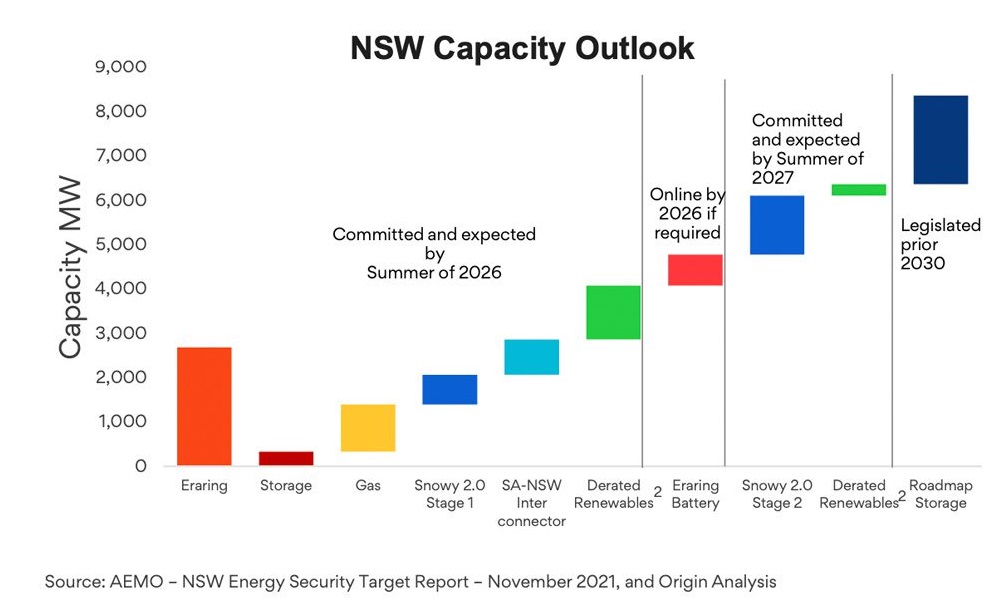Origin Energy has announced that the closure of Australia’s largest power station – the 2800 MW Eraring coal power station – will be brought forward seven years to 2025.
The announcement has sparked a wave of concern about New South Wales being able to meet electricity demand as well as rumblings of an electricity price spike.
New South Wales Energy Minister Matt Kean believes the state’s energy supply and prices will not be affected because the influx of renewables and battery storage will fill the gap left by Eraring’s closure.
Origin will construct a 700 MW battery at the Eraring site and the New South Wales Government has also announced a 700 MW battery as part of its renewable energy roadmap.
Eraring will be the second coal generator to shutter its doors in the next three years. AGL Energy’s long protracted closure of its 2000 MW Liddell plant will also come to an end within the next 18 months.
On top of that, Sunset Power’s 1,320 MW Vales Point power plant will also close by 2028.
Put into context, that means just over 6,000 MW of power will exit the National Energy Market within the next six years.
And given the pattern of accelerating timelines for coal closures, there will be other casualties around the country.
The Australian Energy Market Operator’s modelling has shown that the influx of wind and solar power, as well as battery storage, will allow for a smooth transition, but this has not stopped the markets from getting spooked.
If AEMO has got it right, the transition will indeed be smooth and prices should not spike drastically.
If they are wrong, however, coal plant closures will be delayed. The worst-case scenario would be blackouts and wicked price spikes.
The notice of closure of the Eraring coal power station put forward by Origin is the first under a Federal Government rule introduced in 2018 in the wake of the abrupt closure of Hazelwood in Victoria’s Latrobe Valley in 2017 which sparked an energy price crisis.
Origin chief Frank Calabria said Eraring would simply become unprofitable by 2025, but did not rule out selling the plant if an offer came in.
Why has the Eraring coal power station become unprofitable?
Broken down very simply, the renewable energy generated from wind and solar is cheaper to produce than coal-fired electricity.
Renewable generation technology continues to improve, bringing lower generation costs and better yields.
Eraring costs up to $250 million a year in fixed and operational costs even before the purchase of coal to fuel it.
It is thought to have been unprofitable at times in 2021 when wholesale electricity prices slumped.
Where gas used to be looked upon as ‘firming generation’, the baton looks to be passing to battery storage which is proving to be far quicker at reaching gaps in supply and to help stabilise the grid when substantial frequency changes occur, sparked by gaps between supply and demand.
Coal power stations burn coal to heat water, which in turn turns to steam to power turbines that spin and generate electricity. The problem that coal generation faces is that it suffers from inertia, meaning that it takes time for this process to take place.
The plants need to be ‘switched on’ 24/7 otherwise they would already be out of business as it is even more costly for them to ramp generation up and down on demand.
The problem is exacerbated by the glut of solar energy that floods into the system during the sunshine hours, often pushing spot prices into negative territory.
Demand then spikes in the evening when the sun goes down, creating the ‘head’ of the duck in the duck curve.
It is only this peak (and very expensive) demand that is keeping things together for the coal generators.
But as ever-increasing numbers of batteries are getting approved and built, it looks to be a foregone conclusion to say that demand will soon be satisfied by stored electricity.
On top of this, renewables will start being shipped in from South Australia by 2024 when a new interconnector is completed and comes into play.
Will NSW be able to keep the lights on?

New South Wales Energy Minister Matt Kean believes that the massive amount of renewable energy investment in the state, coupled with the interconnector to South Australia will mean that there will be plenty of electricity to spare.
He also said that several super batteries were due to come online before Eraring exited the market.
Follow the latest energy sector news
Infrastructure gaps may affect energy supply and prices in the country as well as your energy costs.
That’s why, as an energy broker, we’re committed to keeping you informed about the latest developments in the energy sector.
You can see all this in our blogs and news section or sign up to our monthly newsletter to get updates directly in your inbox.
If you want to create a positive impact on your business’ electricity or natural gas bills, get in touch with our Energy Experts.
We’ll be your guide through the energy cost-reduction process. Call us at 1300-852-770 or email us at hello@leadingedgeenergy.com.au and we’ll get you started.
We source, analyse, compare and rank commercial, industrial and multisite energy quotes. Obligation Free.
Chat with one of our experienced consultants today and get the insights your business needs to help manage the risks associated with volatile electricity and natural gas markets. Our energy procurement service is obligation-free and provides a time-saving way of securing lower energy rates from our panel of energy retailers.














